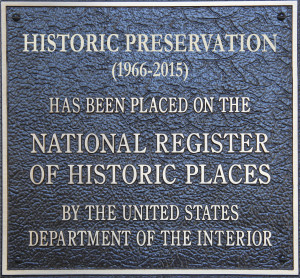
movement itself as a historic period.
To honor the 50th anniversary of the passage of the National Historic Preservation Act, the preservation movement itself is now being considered for inclusion in the National Register of Historic Places. If approved, the designation would effectively prohibit any future changes to the now 50-year-old historic preservation field. But, regardless of the success of the proposed designation, the mere realization that preservation is historic has spiraled into an existential crisis from which the field may never fully recover.
Bill Newman, who is best known for his prolific filibustering of historic review board meetings, spent more than 500 hours preparing the nomination. If approved by the National Park Service, the listing would take effect next year. To-date, 36 preservation organizations and 14 cities have, counterintuitively, objected to listing preservation as historic.
“It’s poetic justice to freeze historic preservation in amber, just as preservationists have done to thousands of properties across the country,” says Newman. The 118-page nomination features research, photographs, and a lengthy interview with the founders of the Tennis Shoe Club, a national organization that has hosted tens of thousands of poorly-attended Victorian tea parties since 1965.
Merely an Era?
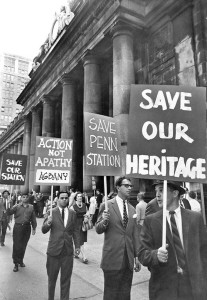
considered by many to be “historic.”
Practitioners use the term “era of significance” to define the period of time during which a significant event took place. “We are now documenting our own period of significance,” says Richard Ellicott, a professor at Savannah College of Art and Design. Ellicott championed a recent effort to designate the Savannah Historic District a second time to honor its first listing five decades ago. But, despite such self-congratulatory efforts, the professor notes that many of his students are considering “less musty” careers now that historic preservation is turning the ripe old age of 50.
Stephanie Kline, a graduate student at the University of Oregon, has spent the past year researching the history of historic preservation in Portland. “The tools, the language, and the even the people haven’t changed in 50 years.” An exhibit of Oregonian quotes demonstrating the shocking continuity of Portland’s preservation movement over the past half-century is set to open at the History Center next month. “It’s as if the preservation movement hasn’t aged a day,” says Kline.
Future of Preservation “Just Too Meta”
The field’s coming of age isn’t just an academic case study—it is also affecting the mental health of many preservation professionals. One former Philadelphia preservationist, Harold White, suddenly closed his history consulting business in February after learning of the National Register nomination. “As preservationists, we are trained only to look backward, never forward. That the field could be considered historic wasn’t on anyone’s radar. Continuing to practice preservation felt just too meta.” White recently accepted a job at the Home Builders Association.
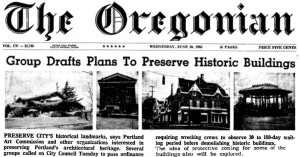
that city. This June 1965 article is eerily similar in substance and in wording to
one published in February 2015.
Mr. White isn’t the only preservationist facing existential crisis. A former New York City Landmarks Commissioner, whose name was withheld from this story, was recently diagnosed with Survivor’s Guilt for his 1968 tie-breaking vote that favored an unadorned 1890s townhouse over a proposed tower designed by architect Ludwig Mies van der Rohe. A consortium of architectural historians recently determined that the proposed design would have been “the most historically significant Modern building in Manhattan” had it not been denied by the Commission.
Psychologists have termed this emergent crisis Historic Significance Cognitive Anxiety Disorder. In recent months, thousands of preservationists have emerged from their normal bookish isolation to seek help from actual humans. In addition to mounting concern about the Disorder, counselors across the country are also reporting significant increases in patients struggling with overwhelming insecurity related to “aspects of integrity.”
A Sinking Ship
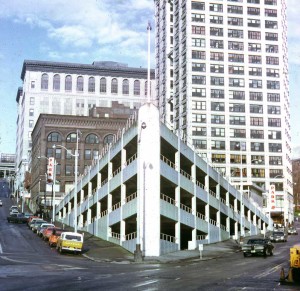
Image Courtesy Lawton Gowey.
No building better embodies the crisis than Seattle’s Sinking Ship parking garage. Built in 1965, the horrible looking building is a symbol of the destruction of many of the city’s earliest buildings and is often cited as the genesis of efforts to save Seattle’s historic architecture. However, despite decades-old disdain for the building, many now consider the Sinking Ship to be Seattle’s most historic building.
The National Park Service recently announced that the garage will become a National Historic Landmark due to its “extreme significance in galvanizing the historic preservation movement.” The listing was opposed by several historic preservation groups, including the Washington Preservation Alliance. Alliance Director Shelly Ellensburg abruptly announced her retirement on Tuesday, stating that “If the Sinking Ship is historic, then the entire historic preservation field has gone down with it.”
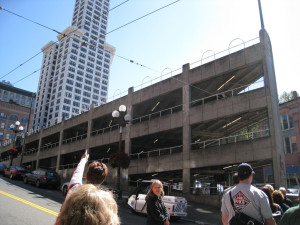
destination. Image courtesy James Lin.
To commemorate the 50th anniversary of the garage’s opening, the Seattle City Council next week is expected to pass a resolution declaring historic preservation a “victory.” If passed, the resolution will reassign preservation staff so that the City can escape “an otherwise endless cycle of preservation.” Similar resolutions are being considered in San Francisco and Washington, D.C.
The National Park Service will hold a public hearing on the National Register Nomination today, April Fools Day.


How am I not seeing this until now?! This is amazing.